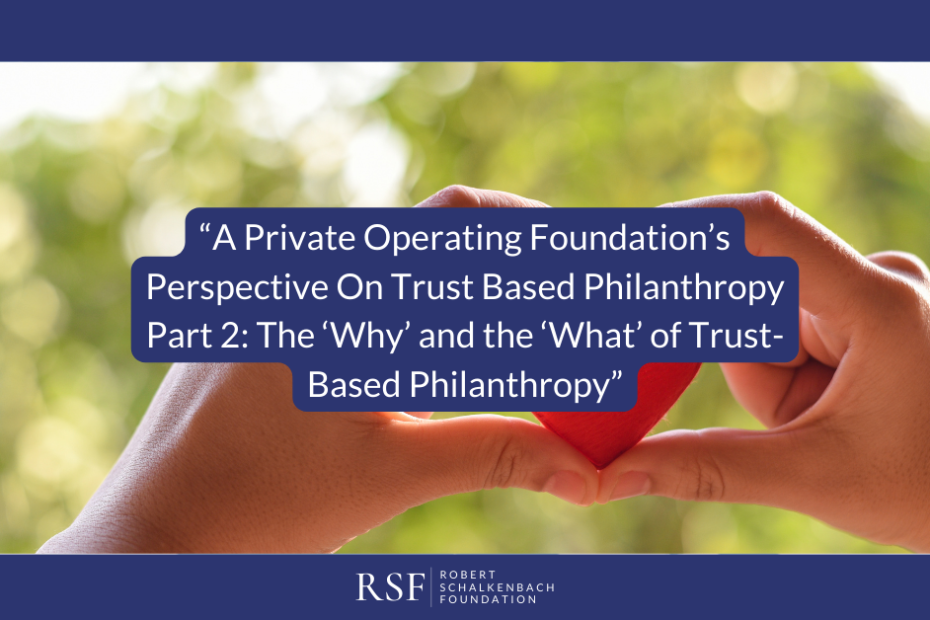As discussed in Part I of this series, the Tax Reform Act of 1969 did much to distinguish foundations from other public charities and create legal distinctions between foundation types. One thing it did not affect, however, was the locus of relational power, which still rested firmly with the wealthy foundations rather than the recipients of their philanthropy. Many modern criticisms of institutional philanthropy focus on this imbalance and its downstream effects.
What grant-making foundations typically describe in terms of due diligence and “outcome-oriented giving,” for example, can leave grantees feeling overburdened by lengthy applications and micromanaged by nuanced reporting requirements. Couple these administrative burdens with many grantors’ preference for annual, rather than multi-year awards, and the client-serving nonprofits on the receiving end of foundation gifts can easily find themselves forced to choose between spending time and energy satisfying funders’ requirements or actually serving their target populations. In short, “the millionaire” still largely maintains their role as “trustee for the poor” when it comes to foundation giving.
The Shift to “Trust-Based Philanthropy”
Long before the onset of the COVID-19 pandemic, private foundations had come under scrutiny for what many saw as their opaque and unnecessarily onerous funding mechanisms, and it wasn’t just the wasteful nature of these practices that were considered problematic. Some of the most pointed criticisms of traditional foundation giving focused on how these practices perpetuate racial disparities, with fewer philanthropic dollars going to organizations with BIPOC leaders and those focused on issues that disproportionately affect non-White populations.
Some private foundations, such as the Whitman Institute and its partner organizations, began formally seeking to address these criticisms as early as 2014. But it was in the days of the pandemic-induced global shutdown, when many local nonprofits scrambled to meet new and ever-expanding community demands in real time, that the need to shift the balance of power to more substantially favor grantees came into stark relief. Once annoying administrative hoops and funding delays were now, quite literally, matters of life or death. The push to level the power playing field intensified dramatically, with a group of major foundations leading the way.
The new approach to foundation-giving developed against the backdrop of the global health crisis is called trust-based philanthropy. This type of foundation giving references four core values (culture, structures, practice, and leadership), and makes use of six specific practices (multi-year, unrestricted awards; grantors “doing the homework to learn about potential grantees; simplified paperwork, funder transparency and responsiveness; a healthy grantor-grantee feedback loop; and foundation “support beyond the check”).
Proponents of trust-based philanthropy herald its efficiency, nimbleness, and equity. And judging by the results of the Ford Foundation’s BUILD Program or anything supported by The Patterson Foundation, this approach to giving can be highly effective.
Of course, this style of grantmaking is not without naysayers. The world’s biggest spending private foundation, the Bill and Melinda Gates Foundation, for example, finds it incompatible with what their CEO, Mark Suzman, describes as their focus on “clear outcomes and metrics and objectives.” And in the now viral article “My Organization Nixed Trust-Based Philanthropy. Here’s What We Discovered,” author Dan Goldberg goes into great detail about why foundations like his own Call of Duty Endowment prefer less arms-length, more metrics-centered approaches. From these leaders’ comments, it appears that when a funder employs subject matter experts, and their focus is on generating scientific knowledge or broadly generalizable programming for clients nationwide, trust-based philanthropy may not be a fit.
When is trust-based philanthropy appropriate?
It appears that the extension of trust based on lived experience may be best suited to situations where a particular community needs support, and the grantees, not grantors, hold the knowledge necessary to effect the necessary changes. There are many circumstances in which these criteria are met, and climate change work––something the Robert Schalkenbach Foundation has recently committed to pursuing, is an obvious example.
Given that philanthropy is just a small part of a private operating foundation’s activities, how can the principles of trust-based philanthropy be embraced? Part III of this series will consider this important question, recognizing that these efforts are very much a work in progress.

